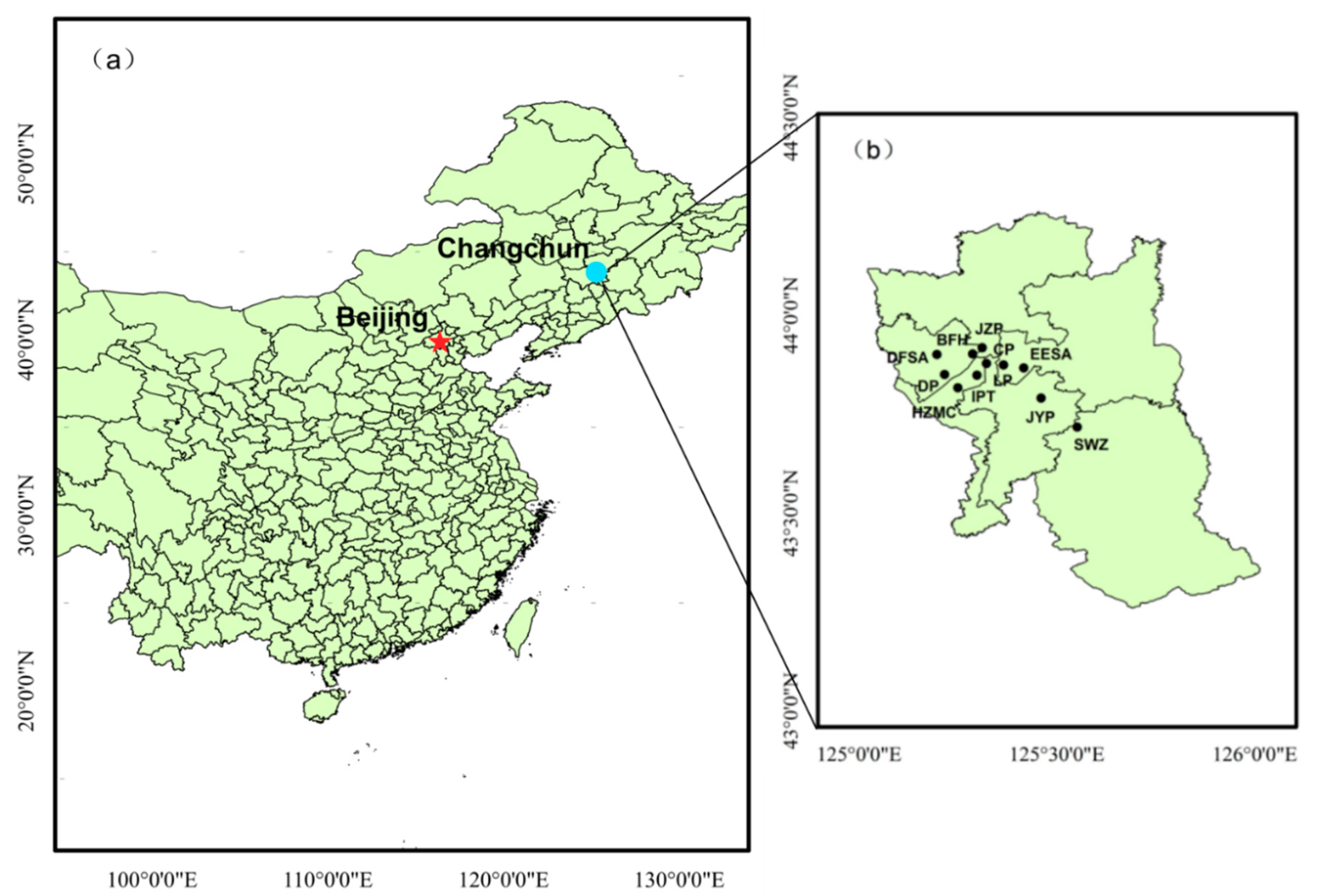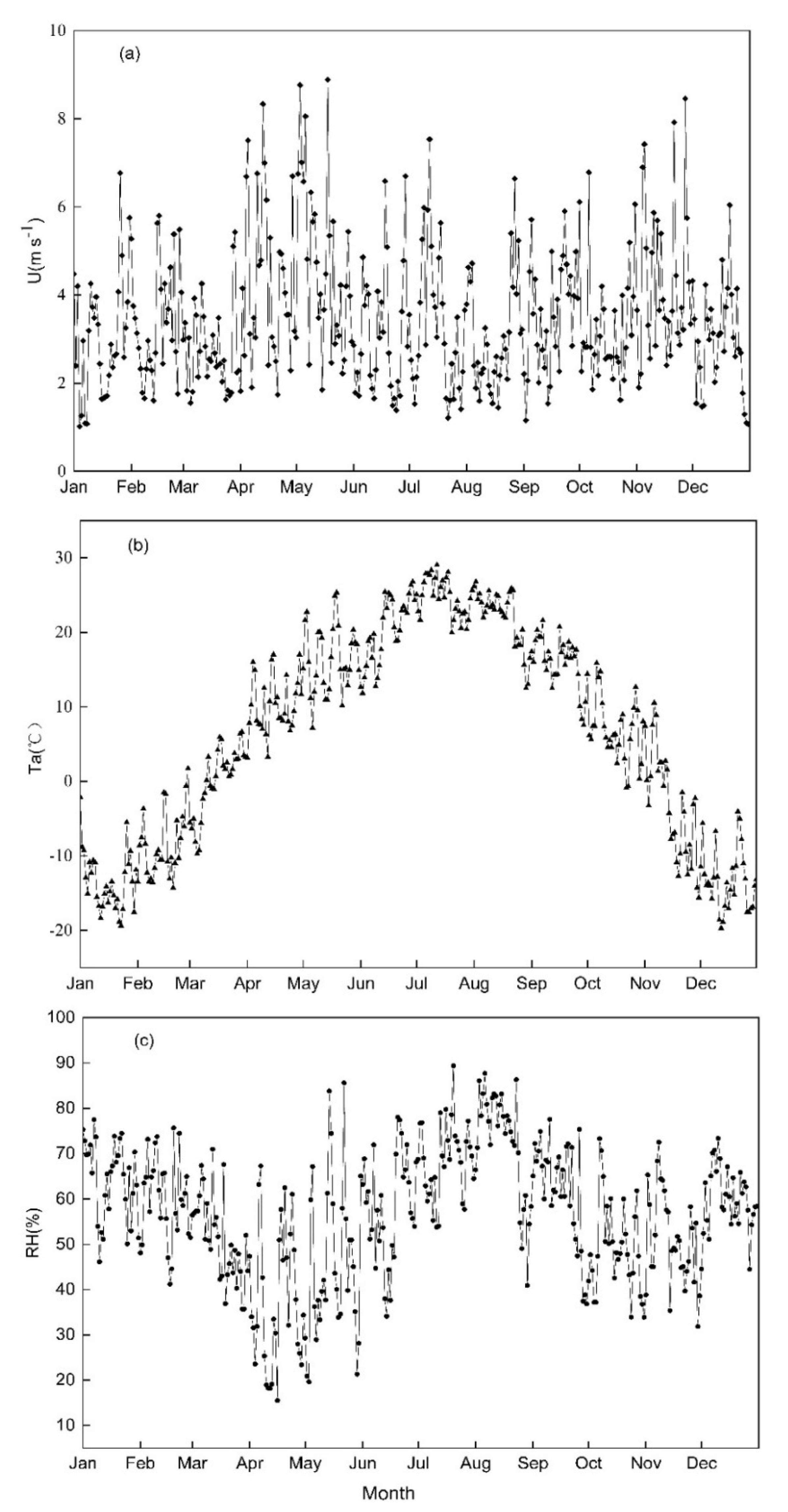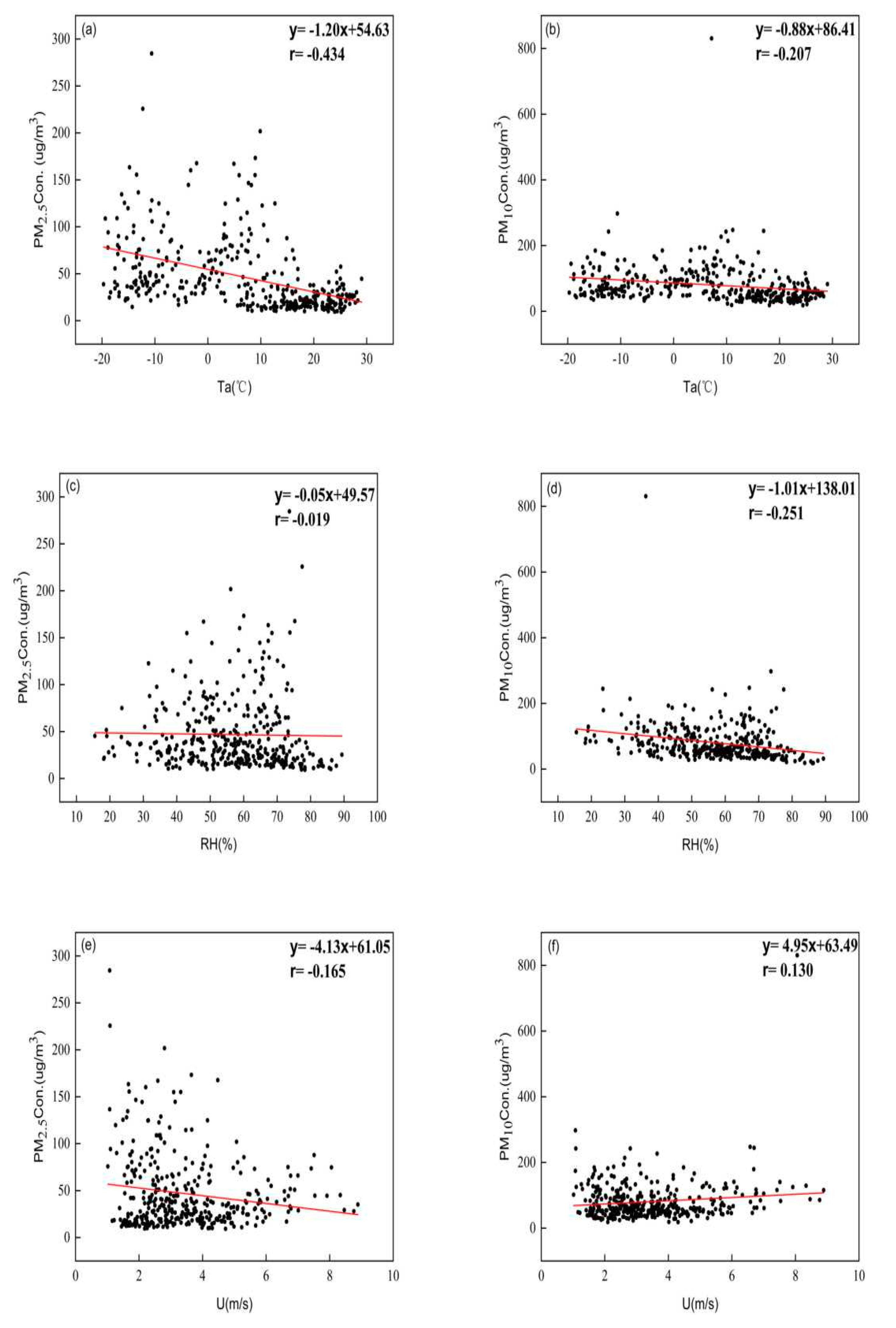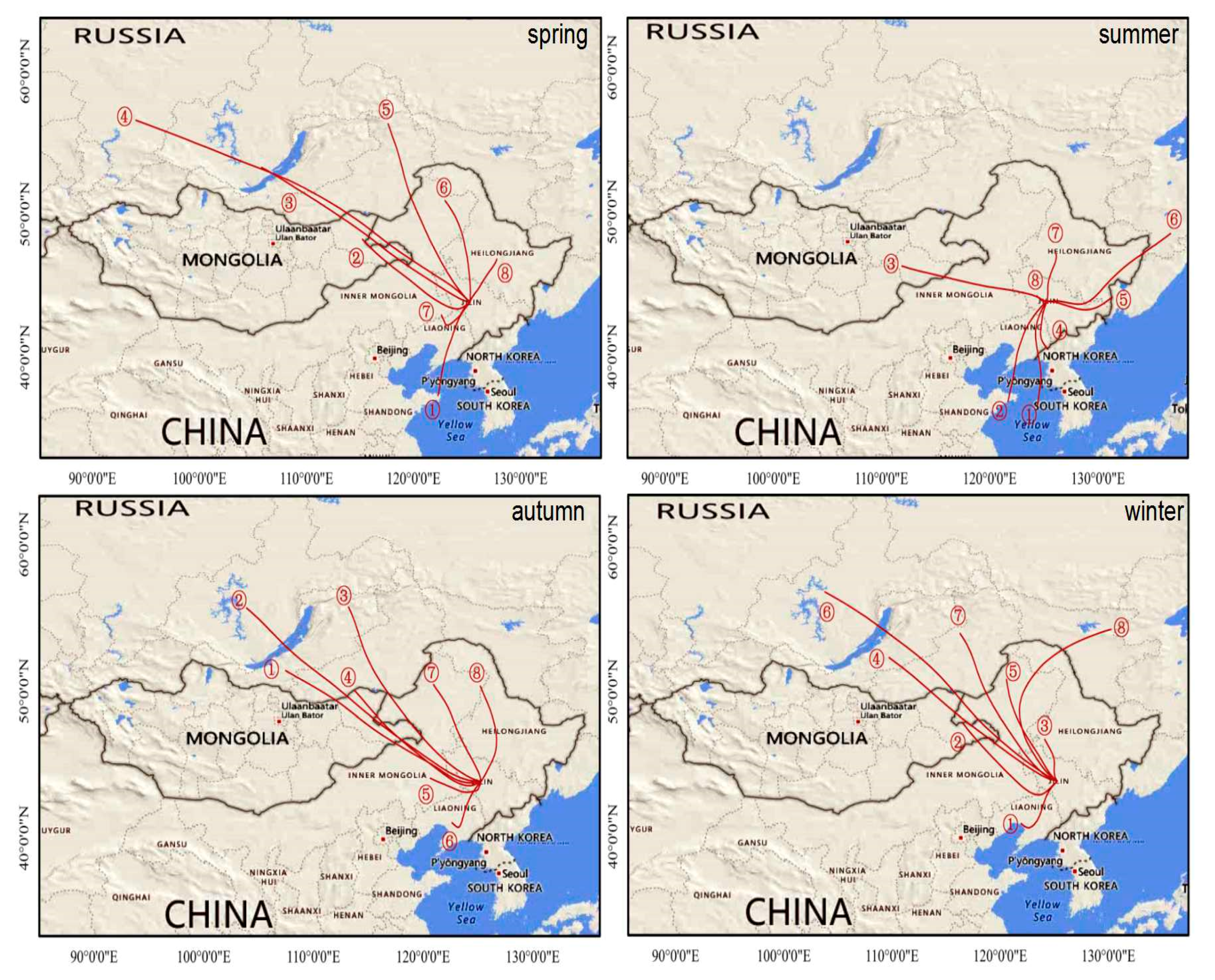Temporal and Spatial Distribution Characteristics of Atmospheric Particulate Matter (PM10 and PM2.5) in Changchun and Analysis of Its Influencing Factors
Abstract
:1. Introduction
2. Materials and Methods
2.1. Sampling Sites and Data
2.2. HYSPLIT Model and Backward Trajectory
2.3. Trajectory Clustering Analysis
3. Result and Discussion
3.1. Temporal Characteristics of Atmospheric PM in Changchun
3.1.1. Quarterly and Monthly Variations in PM Mass Concentrations
3.1.2. Diurnal Variation in PM Concentrations
3.2. Spatial Distribution of PM Mass Concentrations
3.3. Relationship between PM Concentrations and Some Meteorological Parameters
3.4. Backward Trajectory Clustering Analysis
4. Conclusions
Author Contributions
Funding
Conflicts of Interest
References
- Han, L.; Zhou, W.; Li, W.; Li, L. Impact of urbanization level on urban air quality: A case of fine particles (PM2.5) in Chinese cities. Environ. Pollut. 2014, 194, 163–170. [Google Scholar] [CrossRef] [PubMed]
- Du, Y.; Sun, T.; Peng, J. Direct and spillover effects of urbanization on PM2.5 concentrations in China’s top three urban agglomerations. J. Clean Prod. 2018, 190, 72–83. [Google Scholar] [CrossRef]
- Chen, Z.; Barros, C.P.; Gil-Alana, L.A. The persistence of air pollution in four mega-cities of China. Habitat Int. 2016, 56, 103–108. [Google Scholar] [CrossRef] [Green Version]
- Qing, G.; Fu, L.; Li, Y. Spatial-temporal variations and mineral dust fractions in particulate matter mass concentrations in an urban area of northwestern China. J. Environ. Manag. 2018, 222, 95–103. [Google Scholar]
- Zhang, X.P.; Gong, Z.Z. Spatiotemporal characteristics of urban air quality in China and geographic detection of their determinants. J. Geogr. Sci. 2018, 28, 563–578. [Google Scholar] [CrossRef] [Green Version]
- Sun, Z.; Zhan, D.S. Spatio-temporal Characteristics and Geographical Determinants of Air Quality in Cities at the Prefecture Level and Above in China. Chin. Geogr. Sci. 2019, 29, 316–324. [Google Scholar] [CrossRef]
- Wang, Z.B.; Fang, C.L. Spatial-temporal characteristics and determinants of PM2.5 in the Bohai Rim Urban Agglomeration. Chemosphere 2016, 148, 148–162. [Google Scholar] [CrossRef]
- Zhao, H.J.; Che, H.Z.; Ma, Y.J. Temporal variability of the visibility, particulate matter mass concentration and aerosol optical properties over an urban site in Northeast China. Atmos. Res. 2015, 166, 204–212. [Google Scholar] [CrossRef]
- Wang, J.L.; Zhang, Y.H.; Shao, M.; Liu, X.L. Quantitative relationship between visibility and mass concentration of PM2.5 in Beijing. J. Environ. Sci. 2006, 18, 475–481. [Google Scholar]
- Wu, J.; Cheng, W.; Lu, H.J. The Effect of Particulate Matter on Visibility in Hangzhou, China. J. Environ. Sci. Manag. 2018, 21, 100–109. [Google Scholar]
- Huang, J.P.; Wang, T.H.; Wang, W.C. Climate effects of dust aerosols over East Asian arid and semiarid regions. J. Geophys. Res. Atmos. 2014, 119, 11398–11416. [Google Scholar] [CrossRef]
- Tainio, M.; Juda-Rezler, K.; Reizer, M. Future climate and adverse health effects caused by fine particulate matter air pollution: Case study for Poland. Reg. Environ. Chang. 2013, 13, 705–715. [Google Scholar] [CrossRef]
- Pienkosz, B.D.; Saari, R.K.; Monier, E. Natural Variability in Projections of Climate Change Impacts on Fine Particulate Matter Pollution. Earth’s Future 2019, 7, 762–770. [Google Scholar] [CrossRef] [Green Version]
- Tian, Y.H.; Xiang, X.; Juan, J. Short-term effects of ambient fine particulate matter pollution on hospital visits for chronic obstructive pulmonary disease in Beijing, China. Environ. Health 2018, 17, 21. [Google Scholar] [CrossRef]
- Xu, Q.; Li, X.; Wang, S. Fine Particulate Air Pollution and Hospital Emergency Room Visits for Respiratory Disease in Urban Areas in Beijing, China, in 2013. PLoS ONE 2016, 11, e0153099. [Google Scholar] [CrossRef]
- Li, G.; Huang, J.; Xu, G. The short term burden of ambient fine particulate matter on chronic obstructive pulmonary disease in Ningbo, China. Environ. Health 2017, 16, 54. [Google Scholar] [CrossRef] [Green Version]
- Clements, N.; Hannigan, M.P.; Miller, S.L. Comparisons of urban and rural PM10–2.5 and PM2.5 mass concentrations and semi-volatile fractions in northeastern Colorado. Atmos. Chem. Phys. 2016, 16, 7469–7484. [Google Scholar] [CrossRef]
- Tiwari, S.; Bisht, D.S.; Srivastava, A.K. Variability in atmospheric particulates and meteorological effects on their mass concentrations over Delhi, India. Atmos. Res. 2014, 145, 45–56. [Google Scholar] [CrossRef]
- Tuan, V.V.; Jakub, O.; Vladimir, Z. Physical properties and lung deposition of particles emitted from five major indoor sources. Air Qual. Atmos. Health 2016, 10, 1–14. [Google Scholar] [Green Version]
- Song, Y.S.; Tao, Y. Transmission Electron Microscope Study on the Physical and Chemical Characteristics of Atmospheric Particulate Matter PM1.0 in Heavily Polluted Weather. Acta Microsc. 2019, 28, 726–732. [Google Scholar]
- Li, J.; Qi, Z.; Li, M. Physical and Chemical Characteristics of Condensable Particulate Matter from an Ultralow-Emission Coal-Fired Power Plant. Energy Fuels 2017, 31, 1778–1785. [Google Scholar] [CrossRef]
- Li, H.; Wang, Q.; Yang, M. Chemical characterization and source apportionment of PM2.5 aerosols in a megacity of Southeast China. Atmos. Res. 2016, 181, 288–299. [Google Scholar] [CrossRef]
- Liang, Z.; Zhao, X.; Chen, J. Seasonal characteristics of chemical compositions and sources identification of PM2.5 in Zhuhai, China. Environ. Geochem. Health 2018, 41, 715–728. [Google Scholar] [CrossRef] [PubMed]
- Li, T.C.; Yuan, C.S.; Lo, K.C.; Hung, C.H.; Wu, S.P.; Tong, C. Seasonal Variation and Chemical Characteristics of Atmospheric Particles at Three Islands in the Taiwan Strait. Aerosol Air Qual. Res. 2015, 15, 2277–2290. [Google Scholar] [CrossRef] [Green Version]
- Nam, J.; Kim, S.W.; Park, R.J. Changes in column aerosol optical depth and ground-level particulate matter concentration over East Asia. Air Qual. Atmos. Health 2018, 11, 49–60. [Google Scholar] [CrossRef]
- Tiwari, S.; Hopke, P.K. Variability in optical properties of atmospheric aerosols and their frequency distribution over a mega city “New Delhi,” India. Environ. Sci. Pollut. Res. 2016, 23, 8781–8793. [Google Scholar] [CrossRef]
- Zhang, H.L.; Wang, Y.G.; Hu, J.L. Relationships between meteorological parameters and criteria air pollutants in three megacities in China. Environ. Res. 2015, 140, 242–254. [Google Scholar] [CrossRef]
- Kliengchuay, W.; Meeyai, A.C.; Worakhunpiset, S. Relationships between Meteorological Parameters and Particulate Matter in Mae Hong Son Province, Thailand. Int. J. Environ. Res. Public Health 2018, 15, 2801. [Google Scholar] [CrossRef]
- Trivedi, D.K.; Ali, K.; Beig, G. Impact of meteorological parameters on the development of fine and coarse particles over Delhi. Sci. Total Environ. 2014, 478, 175–183. [Google Scholar] [CrossRef]
- Fang, C.; Zhang, Z.; Jin, M. Pollution Characteristics of PM2.5 Aerosol during Haze Periods in Changchun, China. Aerosol Air Qual. Res. 2017, 17, 888–895. [Google Scholar] [CrossRef]
- Wang, J.; Yang, L.; Ma, T. Source apportionment research of fine particulate matter in the atmosphere by PAHs. Chem. Res. Chin. Univ. 2016, 32, 746–753. [Google Scholar] [CrossRef]
- Stein, A.F.; Draxler, R.R.; Rolph, G.D. NOAA’s HYSPLIT atmospheric transport and dispersion modeling system. Bull. Am. Meteorol. Soc. 2015, 96, 2059–2077. [Google Scholar] [CrossRef]
- Chai, T.; Crawford, A.; Stunder, B. Improving volcanic ash predictions with the HYSPLIT dispersion model by assimilating MODIS satellite retrievals. Atmos. Chem. Phys. Discuss. 2016, 17, 2865–2879. [Google Scholar] [CrossRef]
- Ashrafi, K.; Shafiepour-Motlagh, M.; Aslemand, A. Dust storm simulation over Iran using HYSPLIT. J. Environ. Health Sci. Eng. 2014, 12, 9. [Google Scholar] [CrossRef]
- Rashki, A.; Kaskaoutis, D.G.; Francois, P. Dust-storm dynamics over Sistan region, Iran: Seasonality, transport characteristics and affected areas. Aeolian Res. 2015, 16, 35–48. [Google Scholar] [CrossRef]
- Qiusheng, H.; Wendi, G.; Guixiang, Z. Characteristics and Seasonal Variations of Carbonaceous Species in PM2.5 in Taiyuan, China. Atmosphere 2015, 6, 850–862. [Google Scholar]
- Wang, X.; Wei, W.; Cheng, S. Characteristics and classification of PM2.5, pollution episodes in Beijing from 2013 to 2015. Sci. Total Environ. 2018, 612, 170–179. [Google Scholar] [CrossRef]
- Li, Y.; Chen, Q.; Zhao, H.; Wang, L.; Tao, R. Variations in PM10, PM2.5 and PM1.0 in an urban area of the Sichuan Basin and their relation to meteorological factors. Atmosphere 2015, 6, 150–163. [Google Scholar] [CrossRef]
- Tang, G.; Zhang, J.; Zhu, X. Mixing layer height and its implications for air pollution in Beijing, China. Atmos. Chem. Phys. 2016, 16, 2459–2475. [Google Scholar] [CrossRef]
- Zhao, S.; Yu, Y.; Yin, D. Annual and diurnal variations of gaseous and particulate pollutants in 31 provincial capital cities based on in situ air quality monitoring data from China National Environmental Monitoring Center. Environ. Int. 2016, 86, 92–106. [Google Scholar] [CrossRef]
- Westerdahl, D.; Wang, X.; Pan, X. Characterization of on-road vehicle emission factors and microenvironmental air quality in Beijing, China. Atmos. Environ. 2009, 43, 697–705. [Google Scholar] [CrossRef]
- Li, X.L.; Klose, M.; Shao, Y. Convective turbulent dust emission (CTDE) observed over Horqin Sandy Land area and validation of a CTDE scheme. J. Geophys. Res. Atmos. 2014, 119, 9980–9992. [Google Scholar] [CrossRef]
- Li, H.; Hai, L.Z.; Xin, X. Precipitation and Its Effects on Atmospheric Pollutants in a Representative Region of Beijing in Summer. Environ. Sci. 2017, 38, 2211–2217. [Google Scholar]
- Zhao, H.; Che, H.; Zhang, X. Characteristics of visibility and particulate matter (PM) in an urban area of Northeast China. Atmos. Pollut. Res. 2013, 4, 427–434. [Google Scholar] [CrossRef] [Green Version]
- Li, X.; Ma, Y.; Wang, Y. Temporal and spatial analyses of particulate matter (PM10 and PM2.5) and its relationship with meteorological parameters over an urban city in northeast China. Atmos. Res. 2017, 198, 185–193. [Google Scholar] [CrossRef]
- Li, X.; Zhang, H. Seasonal variations in dust concentration and dust emission observed over Horqin Sandy Land area in China from December 2010 to November 2011. Atmos. Environ. 2012, 61, 56–65. [Google Scholar] [CrossRef]









| Name | Environmental Air Quality Functional Area | Major Source of Pollution (Area) | Wind Direction |
|---|---|---|---|
| Children’s Park (CP) | II | Urban and rural | Upwind |
| Bus Factory Hospital (BFH) | II | Industrial discharge | Upwind |
| Institute of Posts and Telecommunications (IPT) | II | Densely populated | Upwind |
| Labour Park (LP) | II | Densely populated | Downwind |
| High-Tech Zone Management Committee (HZMC) | II | Urban and rural | Upwind |
| Daishan Park (DP) | II | Industrial discharge | Upwind |
| Jingyue Park (JYP) | I | Natural reserve | Side wind |
| Economic Development Zone Environment Sanitary Administration (EESA) | II | Densely populated | Downwind |
| Junzilan Park (JZP) | II | Vehicle emission | Downwind |
| Shuaiwanzi (SWZ) | I | Background | Side wind |
| Site | 1 | 2 | 3 | 4 | Annual | |
|---|---|---|---|---|---|---|
| Changchun | PM2.5 | 71 | 34 | 19 | 63 | 47 |
| PM10 | 96 | 87 | 46 | 94 | 81 | |
| PM2.5/PM10 | 0.74 | 0.39 | 0.41 | 0.67 | 0.58 | |
| Shenzhen | PM2.5 | 34 | 22 | 19 | 38 | 28 |
| PM10 | 50 | 36 | 31 | 61 | 45 | |
| PM2.5/PM10 | 0.68 | 0.61 | 0.61 | 0.62 | 0.62 | |
| Xiamen | PM2.5 | 38 | 24 | 19 | 27 | 27 |
| PM10 | 61 | 45 | 33 | 53 | 48 | |
| PM2.5/PM10 | 0.62 | 0.53 | 0.58 | 0.51 | 0.56 | |
| Beijing | PM2.5 | 83 | 52 | 49 | 49 | 58 |
| PM10 | 100 | 103 | 76 | 68 | 87 | |
| PM2.5/PM10 | 0.83 | 0.50 | 0.64 | 0.72 | 0.67 | |
| Shanghai | PM2.5 | 46 | 38 | 30 | 40 | 39 |
| PM10 | 57 | 58 | 48 | 62 | 56 | |
| PM2.5/PM10 | 0.81 | 0.66 | 0.63 | 0.65 | 0.70 | |
| Guangzhou | PM2.5 | 46 | 29 | 26 | 41 | 35 |
| PM10 | 68 | 51 | 43 | 61 | 56 | |
| PM2.5/PM10 | 0.68 | 0.57 | 0.60 | 0.67 | 0.63 |
| Ta | RH | U | |
|---|---|---|---|
| PM2.5 | −0.434 ** | −0.019 | −0.165 ** |
| PM10 | −0.207 ** | −0.251 ** | 0.130 * |
| Season | Cluster No. | Direction | Areas of Pathways | Percentage of Total Trajectory (%) | Trajectory Length (km) | PM2.5 (μg m−3) | PM10 (μg m−3) |
|---|---|---|---|---|---|---|---|
| spring | 1 | SW | eastern Shandong, Bohai, Liaoning, southwestern Jilin | 18.10 | 776.88 | 35.15 | 100.55 |
| 2 | NW | eastern Mongolia, northeastern Inner Mongolia, southwestern Jilin | 10.31 | 1004.05 | 22.22 | 68.17 | |
| 3 | NW | southern Russia, northeastern Mongolia, northeastern Inner Mongolia, western Jilin | 9.63 | 1794.19 | 26.87 | 113.89 | |
| 4 | NW | southern Russia, northeastern Mongolia, northeastern Inner Mongolia, northwestern Jilin | 2.05 | 2641.10 | 29.34 | 124.56 | |
| 5 | NW | southeastern Russia, northeastern Inner Mongolia, northwestern Jilin | 9.02 | 1512.81 | 33.61 | 207.05 | |
| 6 | NW | northeastern Inner Mongolia, southwestern Heilongjiang, northwestern Jilin | 13.93 | 818.13 | 23.89 | 59.33 | |
| 7 | NW | eastern Inner Mongolia, central and northern Liaoning, southwestern Jilin | 12.02 | 348.60 | 28.63 | 71.75 | |
| 8 | NE | southwestern Heilongjiang, northern Jilin | 24.93 | 388.64 | 22.51 | 52.07 | |
| summer | 1 | SW | Yellow Sea, Liaoning southwestern Jilin | 14.91 | 823.15 | 26.93 | 53.90 |
| 2 | SW | eastern Shandong, Bohai Liaoning, southwest Jilin | 10.50 | 845.66 | 34.60 | 64.29 | |
| 3 | NW | eastern Mongolia, northeastern Inner Mongolia, western Jilin | 2.99 | 1094.92 | 22.29 | 44.06 | |
| 4 | SW | northwestern north Korea, eastern Liaoning, southwestern Jilin | 32.92 | 391.55 | 20.75 | 46.01 | |
| 5 | E | southeastern Russia, southeastern Heilongjiang, eastern Jilin | 8.86 | 525.83 | 16.14 | 43.55 | |
| 6 | NE | southeastern Russia, southeastern Heilongjiang, eastern Jilin | 2.41 | 1106.42 | 14.18 | 36.61 | |
| 7 | NE | Southwestern Heilongjiang, northern Jilin | 13.09 | 374.02 | 16.17 | 43.84 | |
| 8 | NW | northwestern Jilin | 14.32 | 116.46 | 20.03 | 50.83 | |
| autumn | 1 | NW | southern Russia, northeastern Mongolia, northeastern Inner Mongolia, western Jilin | 5.87 | 1624.84 | 13.06 | 36.07 |
| 2 | NW | southern Russia, northeastern Mongolia, northeastern Inner Mongolia, western Jilin | 10.11 | 2088.90 | 16.37 | 45.28 | |
| 3 | NW | southern Russia, eastern Mongolia, northeastern Inner Mongolia, northwestern Jilin | 9.70 | 1656.88 | 16.90 | 57.40 | |
| 4 | NW | northeastern Mongolia, northeastern Inner Mongolia, western Jilin | 9.43 | 1196.62 | 44.11 | 74.95 | |
| 5 | NW | eastern Inner Mongolia, northern Liaoning, western Jilin | 10.79 | 441.66 | 61.06 | 98.06 | |
| 6 | SW | north-central Liaoning, western Jilin | 27.80 | 452.12 | 37.04 | 67.40 | |
| 7 | NW | northeastern Inner Mongolia, western Heilongjiang northwestern Jilin | 16.26 | 805.60 | 38.12 | 67.08 | |
| 8 | NW | northeastern Inner Mongolia, Heilongjiang, northwestern Jilin | 10.04 | 761.16 | 40.83 | 74.57 | |
| winter | 1 | SW | north Central Liaoning, Jilin | 18.90 | 502.35 | 82.75 | 115.95 |
| 2 | NW | northeastern Mongolia, northeastern Inner Mongolia, northern Liaoning, western Jilin | 13.42 | 975.38 | 66.20 | 93.83 | |
| 3 | NW | southwestern Heilongjiang, northwestern Jilin | 23.26 | 339.38 | 89.35 | 114.67 | |
| 4 | NW | southern Russia, northeastern Mongolia, northeastern Inner Mongolia, northwestern Jilin | 13.20 | 1516.93 | 45.18 | 74.89 | |
| 5 | NW | Northeastern Inner Mongolia, northwestern Jilin | 11.68 | 870.74 | 72.60 | 98.37 | |
| 6 | NW | southern Russia, northeastern Mongolia, northeastern Inner Mongolia, northwestern Jilin | 5.38 | 2123.29 | 25.37 | 65.69 | |
| 7 | NW | southeastern Russia, northeastern Inner Mongolia, northwestern Jilin | 9.76 | 1349.27 | 50.12 | 78.67 | |
| 8 | NE | southeastern Russia, northwestern Heilongjiang, northeastern Inner Mongolia, northwestern Jilin | 4.41 | 1522.04 | 35.02 | 54.83 |
© 2019 by the authors. Licensee MDPI, Basel, Switzerland. This article is an open access article distributed under the terms and conditions of the Creative Commons Attribution (CC BY) license (http://creativecommons.org/licenses/by/4.0/).
Share and Cite
Wang, J.; Xie, X.; Fang, C. Temporal and Spatial Distribution Characteristics of Atmospheric Particulate Matter (PM10 and PM2.5) in Changchun and Analysis of Its Influencing Factors. Atmosphere 2019, 10, 651. https://doi.org/10.3390/atmos10110651
Wang J, Xie X, Fang C. Temporal and Spatial Distribution Characteristics of Atmospheric Particulate Matter (PM10 and PM2.5) in Changchun and Analysis of Its Influencing Factors. Atmosphere. 2019; 10(11):651. https://doi.org/10.3390/atmos10110651
Chicago/Turabian StyleWang, Ju, Xin Xie, and Chunsheng Fang. 2019. "Temporal and Spatial Distribution Characteristics of Atmospheric Particulate Matter (PM10 and PM2.5) in Changchun and Analysis of Its Influencing Factors" Atmosphere 10, no. 11: 651. https://doi.org/10.3390/atmos10110651
APA StyleWang, J., Xie, X., & Fang, C. (2019). Temporal and Spatial Distribution Characteristics of Atmospheric Particulate Matter (PM10 and PM2.5) in Changchun and Analysis of Its Influencing Factors. Atmosphere, 10(11), 651. https://doi.org/10.3390/atmos10110651





